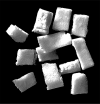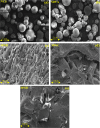Preparation and Characterization of Dual-Modified Cassava Starch-Based Biodegradable Foams for Sustainable Packaging Applications
- PMID: 35722021
- PMCID: PMC9202043
- DOI: 10.1021/acsomega.2c01292
Preparation and Characterization of Dual-Modified Cassava Starch-Based Biodegradable Foams for Sustainable Packaging Applications
Abstract
Starch and its derivatives have recently emerged as a sustainable and renewable alternative for petroleum-based expanded polystyrene (EPS) and expanded polypropylene (EPP) foam materials. In this study, biodegradable foam materials were prepared from cassava starch using a novel dual modification technique, combining microwave treatment and freeze-drying. The foam materials were prepared from starch solutions microwaved over different intervals. The starch-based foam materials were characterized using Fourier transform infrared (FTIR) spectroscopy, thermogravimetric analysis (TGA), X-ray diffraction (XRD), scanning electron microscopy (SEM), 13C nuclear magnetic resonance (13C-NMR) spectroscopy, and compression set test. Moreover, the water absorption capacities and density values of the foam materials were measured according to ASTM standards. The biodegradability test was carried out according to the aerobic compost environment test. The lowest water absorption capacities of 65.56% and 70.83% were exhibited for the cassava starch foam sample (MWB) prepared at a 20 s microwave treatment time and immersed in distilled water for 2 and 24 h, respectively. Furthermore, the lightweight cassava starch-based foam materials displayed density ranging from 124 to 245 kg/m3. The biodegradation test exhibited significant biodegradation of over 50% after 15 days for all the foam materials prepared. These results suggest that the dual-modified cassava starch-based biodegradable foams show potential in sustainable packaging applications by replacing petroleum-based materials.
© 2022 The Authors. Published by American Chemical Society.
Conflict of interest statement
The authors declare no competing financial interest.
Figures








Similar articles
-
Recycling rice husk ash as a filler on biodegradable cassava starch-based foams.Polym Bull (Berl). 2022 Nov 10:1-18. doi: 10.1007/s00289-022-04557-9. Online ahead of print. Polym Bull (Berl). 2022. PMID: 36405401 Free PMC article.
-
Development of biodegradable starch-based foams incorporated with grape stalks for food packaging.Carbohydr Polym. 2019 Dec 1;225:115234. doi: 10.1016/j.carbpol.2019.115234. Epub 2019 Aug 22. Carbohydr Polym. 2019. PMID: 31521283
-
Development of Cassava Starch-Based Foams Incorporating Wastes from the Production of Organic Grape Juice and Grape Seed Oil.ACS Omega. 2025 Feb 18;10(8):8551-8569. doi: 10.1021/acsomega.4c10904. eCollection 2025 Mar 4. ACS Omega. 2025. PMID: 40060844 Free PMC article.
-
Overview on Foam Forming Cellulose Materials for Cushioning Packaging Applications.Polymers (Basel). 2022 May 11;14(10):1963. doi: 10.3390/polym14101963. Polymers (Basel). 2022. PMID: 35631844 Free PMC article. Review.
-
Cassava pomace-based biodegradable packaging materials: a review.J Food Sci Technol. 2024 Jun;61(6):1013-1034. doi: 10.1007/s13197-023-05807-y. Epub 2023 Aug 26. J Food Sci Technol. 2024. PMID: 38562601 Free PMC article. Review.
Cited by
-
The Effects of the Substrate Length and Cultivation Time on the Physical and Mechanical Properties of Mycelium-Based Cushioning Materials from Salix psammophila and Peanut Straw.Biomimetics (Basel). 2025 Jun 5;10(6):371. doi: 10.3390/biomimetics10060371. Biomimetics (Basel). 2025. PMID: 40558341 Free PMC article.
-
Enhancing Thermal Insulation Property and Flexibility of Starch/Poly(butylene adipate terephthalate) (PBAT) Blend Foam by Improving Rheological Properties.Polymers (Basel). 2025 Jan 8;17(2):138. doi: 10.3390/polym17020138. Polymers (Basel). 2025. PMID: 39861211 Free PMC article.
-
Ultrasound-Assisted Polysaccharide Extraction from Grape Skin and Assessment of In Vitro Hypoglycemic Activity of Polysaccharides.Foods. 2025 May 19;14(10):1801. doi: 10.3390/foods14101801. Foods. 2025. PMID: 40428580 Free PMC article.
References
-
- Kannan P.; Biernacki J. J.; Visco D. P. Jr. A review of physical and kinetic models of thermal degradation of expanded polystyrene foam and their application to the lost foam casting process. J. Anal. Appl. Pyrolysis 2007, 78, 162–171. 10.1016/j.jaap.2006.06.005. - DOI
-
- Ramli Sulong N. H.; Mustapa S. A. S.; Abdul Rashid M. K. Application of expanded polystyrene (EPS) in buildings and constructions: A review. J. Appl. Polym. Sci. 2019, 136, 47529.10.1002/app.47529. - DOI
-
- Cinelli P.; Chiellini E.; Lawton J. W.; Imam S. H. Foamed articles based on potato starch, corn fibers and poly (vinyl alcohol). Polym. Degrad. Stab. 2006, 91, 1147–1155. 10.1016/j.polymdegradstab.2005.07.001. - DOI
-
- Glenn G. M.; Orts W. J. Properties of starch-based foam formed by compression / explosion processing. Ind. Crops Prod. 2001, 13, 135–143. 10.1016/S0926-6690(00)00060-1. - DOI
-
- Cronin D. S.; Ouellet S. Low density polyethylene, expanded polystyrene and expanded polypropylene: Strain rate and size effects on mechanical properties. Polym. Test. 2016, 40–50. 10.1016/j.polymertesting.2016.04.018. - DOI
LinkOut - more resources
Full Text Sources

